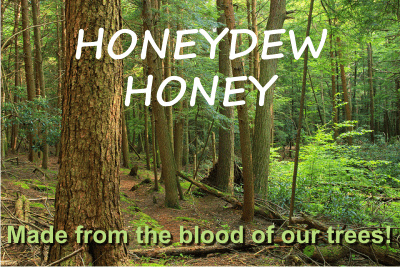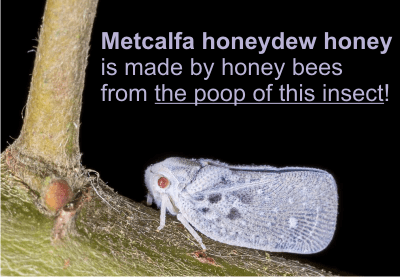What is beechwood honey is a question I put myself after seeing it on Amazon. In Europe there is no such thing as beech honey, there is forest honey and honeydew honey which includes beech. But beechwood honey comes only from New Zealand.
Beeches are trees found all over the world, why only New Zealand has this honey? Because in southern hemisphere beeches are different, even have a different name: Nothofagus, meaning false beech.
These type of beeches are found in Australia, New Zealand, New Guinea, New Caledonia, Argentina and Chile (principally Patagonia and Tierra del Fuego). But only the beechwood honey from NZ and Australia are more popular.
Beechwood honeys from New Zealand
New Zealand has 4 beech species and 1 subspecies:
1. Red beech (Fuscospora fusca). This is the largest of all, reaching 30 meters high and a trunk up to 2 meters thick, topped with a massive crown of branches and leaves. Of all the beeches, red beech is least resistant to unfavourable conditions. It grows on warm, lower- to mid-slopes, and deep, fertile, well-drained soils.
2. Hard beech (Fuscospora truncata). It grows as high as red beech, but its trunk is thinner. It is found further north than other species.
3. Black beech (Fuscospora solandri) , which reaches 25 meters high and can grow in poor soils. Here botanists included a subspecies called Mountain beech (Fuscospora cliffortioides), which is the smallest of New Zealand’s beeches, grows only up to 15 meters and can be found very high on slopes.
4. Silver beech, which grows up to 25 meters high and grows in wet, mountainous areas. It is the most widespread tall tree in Fiordland.
New Zealand has two main types of native forest:
1. conifer–broadleaf forest (including kauri forest) – which grow at low altitudes and is usually cut for the wood.
2. beech forest – which grow at high altitude and thus still pristine and inaccessible.
Northern New Zealand contains beech trees but in a lower percentage and only 40% of North Island forests do. In a forest there can be one or more beech species and together with other trees they form mixed forests such as hard beech–kauri forest in the Auckland area and beech–tawa forest in the central North Island. From these forests we enjoy what is labeled as NZ forest honey.
Southern New Zealand has more beech forests on hills and mountains. Pure beech forest now comprises almost half (about 3 million hectares) of New Zealand’s remaining native forest. Beech trees are found in 80–90% of native forest in the South Island.
Pests, wasps and honeydew in New Zealand
South Island beeches (with the exception of silver beech) are infested with sooty beech scale insects (such as Ultracoelostoma spp. and U. brittini, which produce honeydew – a sugary substance that is eaten by native insects, and birds such as tūī, bellbirds and kākā (the forest parrot). But not only. Lizards, possums, rats, honeybees and wasps have also been recorded feeding on honeydew.
For five months each year, introduced wasps are pests that take most of the honeydew (more than 90%), depriving the native animals of their food, and representing a powerful competitor of honey bees. They also prey on insects, spiders and other invertebrates, further reducing the food of native animals.
Trees have been seen with around 400 wasps crawling over them. New Zealand has some of the highest densities of German and common wasps in the world.
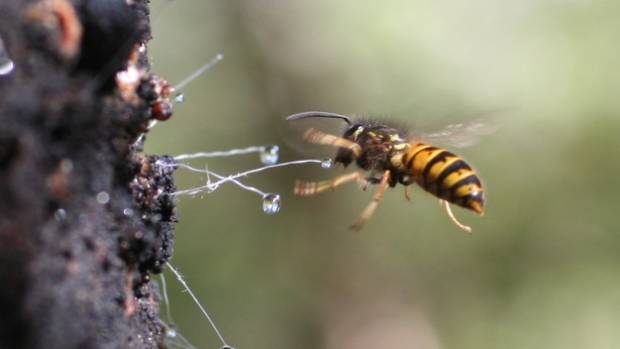 picture credit Alden Williams via stuff.co.nz
picture credit Alden Williams via stuff.co.nz
Beekeepers lose almost $9 million a year due to wasps attacking honey bees, robbing their honey and destroying hives. And almost $60 million a year is lost in unrealised honey production from beech forest honeydew, because they are currently being monopolised by wasps.
The documentary film Bandits of the Beech Forest presented the devastating effects of introduced wasps in New Zealand and won the Environment Prize for Best Film Illustrating Protection, Preservation or Conservation of Bird Life at the Festival du Film de l’Oiseau (source).
Scale insects produce honeydew on beech trees.
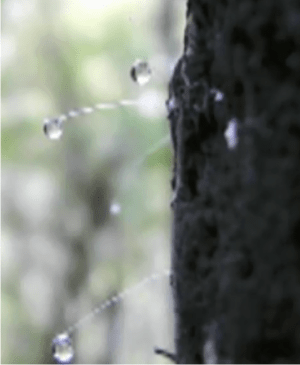 They are small insects that live within the bark of beech and produce honeydew. They are related to aphids but are more simpler in body structure, having only mouth parts and a very long anal tube, which is the one part of the insect that you can see protruding as a thin waxy stem from the bark of the tree. The tube often has a small drop of sweet sugary honeydew on the end.
They are small insects that live within the bark of beech and produce honeydew. They are related to aphids but are more simpler in body structure, having only mouth parts and a very long anal tube, which is the one part of the insect that you can see protruding as a thin waxy stem from the bark of the tree. The tube often has a small drop of sweet sugary honeydew on the end.
Researcher Rosa Henderson, Curator of Sternorrhyncha within the New Zealand Arthropod Collection, describes them as looking like a little flattened sac with no wings or legs. Here is how she describes how they produce honeydew.
The insect inserts its mouth into the phloem of the tree – the internal tube that conducts sugar from the leaves throughout the tree to the roots. This fluid has much sugar and the insect takes in far more than it needs.
Instead of using all this food and getting fat, it secretes the excess sugar through its anal tube, forming small droplets that we call honeydew. Picture credit and more info on Science Learning Hub.
Is this honeydew that good?
Here is a fabulous picture by Jon Sullivan, found on flickr.com and explained as “The inaugural annual beech-licking photo of the Ecol202 field trip.”
Hat off to these open-minded people, who know to enjoy life as it is and appreciate a sweet stuff, from wherever it may come.
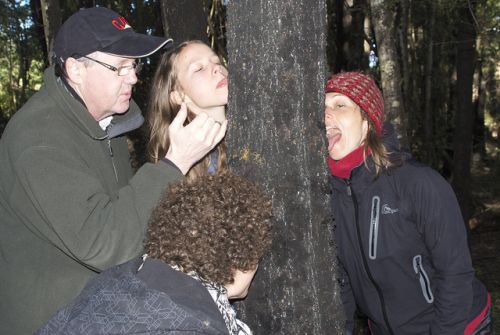
How is beechwood honey?
It’s a honeydew honey made from the honeydew secreted by 2 insects: Ultracoelostoma assimile and U. brittini, after feeding themselves from the sap of black beech (Nothofagus solandri) and red beech (Nothofagus fusca).
Honey bees collect this honeydew and make honey out of it. But wasps are a really serious problem in New Zealand beech forests. They are very dangerous and eat almost all honeydew, leaving way too little for the other insects and birds. Honey bees included.
That is why beechwood honey is rare and pretty expensive compared to other honeydew honeys. I have only found a couple of producers and several online shops that sell it.
There are no studies for this type of honey to reveal its specific health benefits. Here is how Wedderspoon and Airborne, the 2 big producers of this type of honey, describe it:
Color: dark with reddish hints, but depends a lot on the season and geographical area. In spring is light amber, in autumn is more amber. There are some areas that produce darker honeydew and thus darker beechwood honey.
Taste: earthy but refined, with hints of pine resin and caramelized sugar.
Crystallization: very slow
Glucose: 22.9%
Fructose: 33.8%
Sucrose: 0.67%
Oligosaccharides content: high. As a rule honeydews have lower levels of glucose and fructose and higher levels of complex sugars due to the extra enzymatic actions in the sap sucking insect’s gut.
Other sugars: maltose, erlose and melezitose in higher amount than in blossom honeys.
Mineral and trace element content: high
Electrical conductivity: high. The average is 1.19 mS/cm SD .22 mS/cm ( 1,390 records) which is around 10 times the average for flower honeys. (A high conductivity is what differentiate honeydew honey from blossom honey in the laboratory.)
Antioxidant level: high. In a study done at Lincoln University beech honeydew had the highest levels of polyphenolics. Its antioxidant power was comparable to that of other top honeys of NZ: thyme, manuka and rewarewa – all dark colored, strong flavored honeys.
Beech honeydew honey has been found to have an exceptionally high level of iron-binding antioxidant activity. The study Identifying iron-binding antioxidants in New Zealand honeydew honey by Omar, S. B. from the University of Waikato and published in 2013, investigated the stability of the antioxidants on exposure to heat and high and low pH.
His conclusions show that “Complete structural elucidation of the iron-binding antioxidants in honeydew honey could initiate a better understanding of the mechanism of action of the antioxidants.
This could increase the use of honeydew honey in pharmaceutical and nutraceutical products as an iron-binding antioxidant.
There is also the possibility that the identified compound(s) could be synthesised for pharmaceutical use, or serve as lead compounds for the development of other pharmaceutical iron-binding antioxidants.”
Antibacterial honey: high, due to high levels of glucose oxidase (only when the honey is fresh!)
Health benefits of beechwood honey
Beechwood honey shares its properties with the rest of the honeydew honeys. Please read the page What is honeydew honey to see all its characteristics.
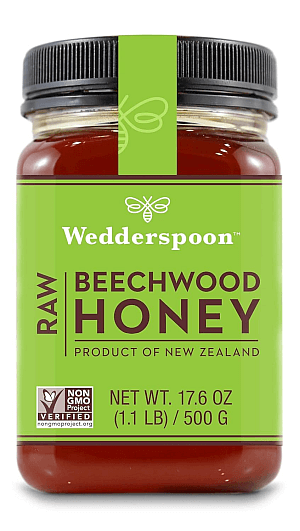
• The high content of oligosaccharides recommends these honeys in constipation. See Honey cures constipation.
• The high content of antioxidants, minerals and trace elements recommends it for anemia and a weak immune system.
• The antioxidant compounds recommend as a gastroprotective product. The concentration of NO2 and NO3 in honeydew honeys is higher than that of blossom honeys. ( BERETTA, G. et al.) The mechanism of gastric protection involves the salivary reduction of nitrate (NO3-) to nitrite (NO2-) and the intragastric formation of nitric oxide (NO), the latter involved in the preservation of the gastric mucosa capillaries and in boosting mucous production.
Other articles on honeydew honeys:
In the kitchen, it pairs well with cheese, as honey softens the bitterness of cheese and enhances its natural sweetness, especially of goat and blue cheese. It is pourable so it spreads well on buttered bread or waffles.
Where to find beechwood honey
There are 2 big producers that sell it: Weedwespoon and Airborne.
• Wedderspoon Raw Beechwood Honey, 17.6 Ounce (picture above)
• Airborne (New Zealand) Beech Forest Honeydew Honey 500g / 17.85oz
===========================
Other references and further reading:
teara.govt.nz/en/southern-beech-forest
doc.govt.nz/nature/native-plants/beech-forest/
sciencelearn.org.nz/resources/1436-honeydew-ecosystem
https://en.wikipedia.org/wiki/Nothofagus
featured picture source via wikipedia commons

